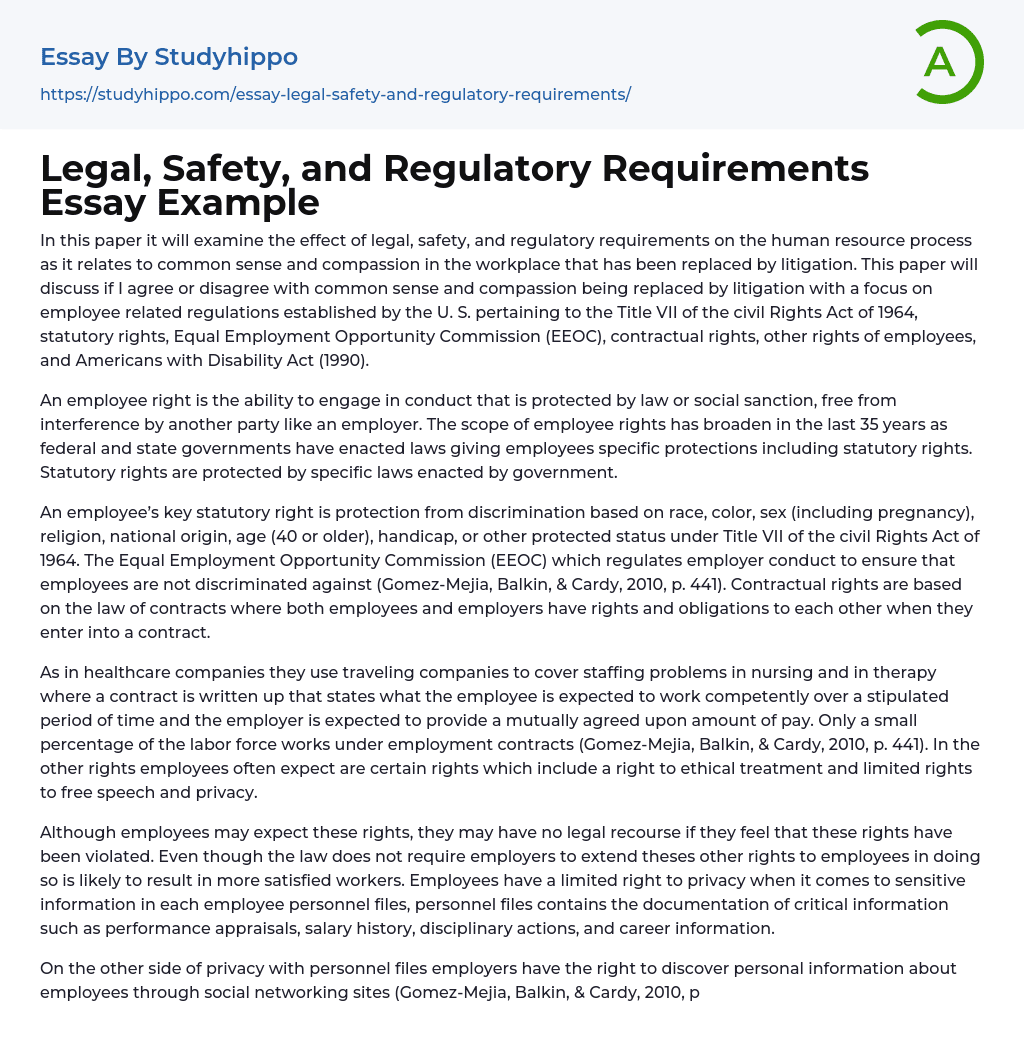The text below analyzes the effects of legal, safety, and regulatory requirements on the human resource process at work. It explores how litigation has replaced common sense and compassion in decision-making. The discussion specifically revolves around various employee regulations including the Civil Rights Act of 1964's Title VII, statutory rights, Equal Employment Opportunity Commission (EEOC), contractual rights, other employee rights, and the Americans with Disabilities Act (1990).
Employee rights have expanded in the last 35 years due to federal and state laws. The purpose of these laws is to protect employees' ability to engage in legally protected activities without employer interference.
The Title VII of the Civil Rights Act of 1964 protects employees from discrimination based on race, color, sex (including pregnancy), religion, national origin, age (40 or older), handicap, or other protected status. The Equal Employment Opportunity C
...ommission (EEOC) enforces this regulation to prevent employee discrimination (Gomez-Mejia, Balkin, & Cardy, 2010, p. 441). Moreover, when employees and employers enter into an agreement, they have contractual rights and responsibilities established by the law of contracts.
Healthcare companies often use traveling companies to resolve staffing problems in the nursing and therapy fields. These companies create contracts that specify the required skills of employees and their agreed-upon salaries. According to Gomez-Mejia, Balkin, & Cardy (2010, p. 441), only a small portion of the workforce is governed by employment contracts. In addition, employees usually expect certain rights including fair treatment, restricted freedom of speech, and limited privacy rights.
Although employees may not have legal recourse if they believe their rights have been violated, providing them with additional rights is likely to enhance job satisfaction.
Moreover, employees possess a restricted privacy right pertaining to sensitive information present in their personnel files, which encompasses crucial data like performance evaluations, salary history, disciplinary records, and career information.
Gomez-Mejia, Balkin, and Cardy (2010, p. 442-443) state that employers may infringe on employees' privacy by accessing personal information on social networking sites. The Americans with Disabilities Act of 1990 also provides individuals with disabilities the same protections as other protected groups under the Civil Rights Act of 1964.
The Americans with Disabilities Act (1990) requires equal access to be provided in employment, transportation, telecommunications, and public services and facilities. The definition of disabilities is continuously broadening through legal cases that challenge its limitations. As a healthcare worker, I believe that prioritizing common sense and compassion should be more important than resorting to litigation within the workplace.
Throughout my 32-year medical career, I have not witnessed any legal conflicts arising between employees and employers. I firmly believe that by advocating for employee rights, conducting oneself with integrity, showing respect towards limited freedom of speech and privacy rights, utilizing common sense and empathy, we can effectively prevent lawsuits from occurring.
The main emphasis of this paper is the influence of legal, safety, and regulatory requirements on human resource processes. These requirements are in place to protect employers from possible lawsuits by employees who are covered by Title VII of the Civil Rights Act of 1964, statutory rights, the Equal Employment Opportunity Commission (EEOC), contractual rights, other employee rights, and the Americans with Disabilities Act (1990).
To my knowledge, I have not witnessed or been informed of a situation where common sense
and compassion in the workplace have been replaced by litigation. There have been no legal cases related to various rights such as those granted by Title VII of the Civil Rights Act of 1964, statutory rights, Equal Employment Opportunity Commission (EEOC), contractual rights, other employee rights, and the Americans with Disability Act (1990). Employers who demonstrate common sense and compassion towards their employees will avoid getting involved in legal conflicts.
- Agreement essays
- Business Law essays
- Common Law essays
- Community Policing essays
- Constitution essays
- Consumer Protection essays
- Contract essays
- Contract Law essays
- Copyright Infringement essays
- Court essays
- Crime essays
- Criminal Law essays
- Employment Law essays
- Family Law essays
- Injustice essays
- Judge essays
- Jury essays
- Justice essays
- Lawsuit essays
- Lawyer essays
- Marijuana Legalization essays
- Ownership essays
- Police essays
- Property essays
- Protection essays
- Security essays
- Tort Law essays
- Treaty essays
- United States Constitution essays
- War on Drugs essays
- American Dream essays
- Barriers To Entry essays
- Capitalism essays
- Central Bank essays
- Compensation essays
- Consumerism essays
- Economic Development essays
- Economic Growth essays
- Economic Inequality essays
- Economic System essays
- Economy essays
- Employment essays
- Export essays
- Finance essays
- Free Trade essays
- Gross Domestic Product essays
- Human Development essays
- Income Inequality essays
- Industry essays
- Inflation essays




